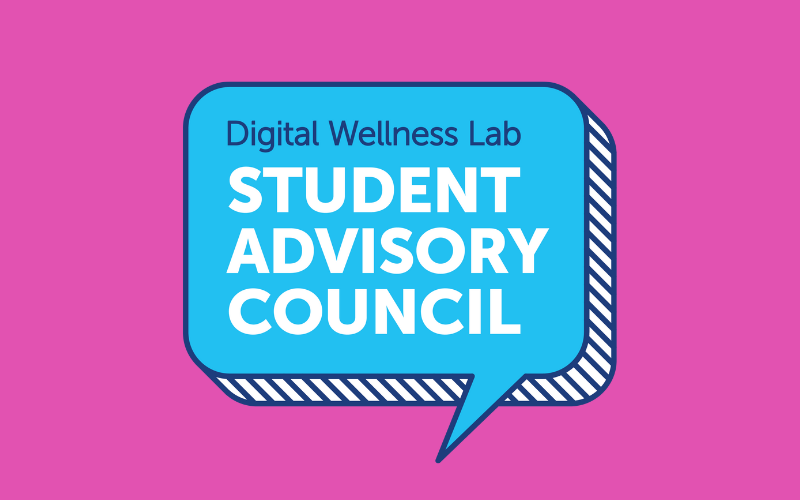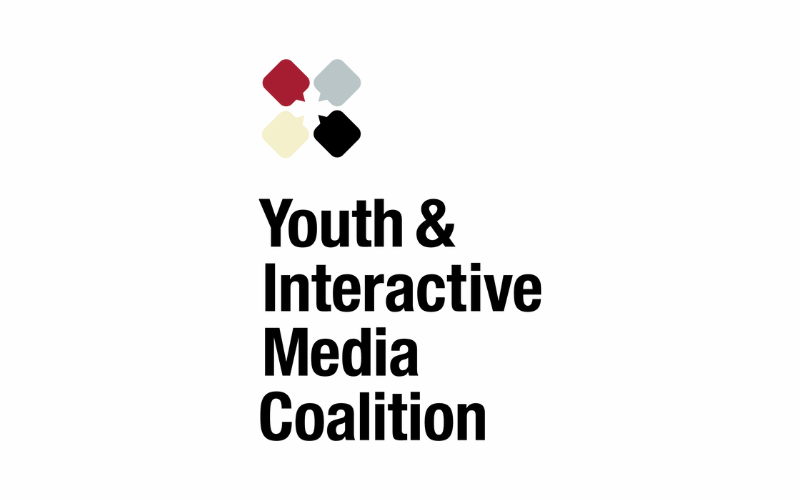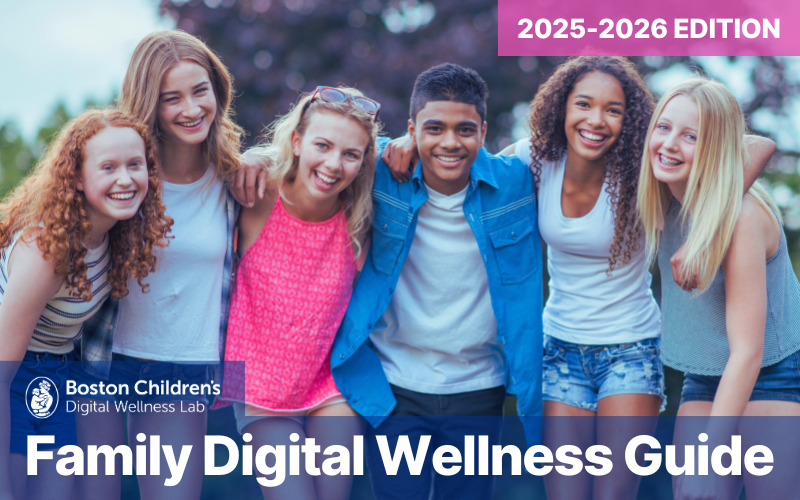Family Digital Wellness Guide
Teen to Young Adult (Ages 13-22)
Foster Independence with Support and Empathy

Adolescence is a transformative period of growth, exploration, and identity formation. And for most teens, technology is deeply integrated into their daily lives. From social media to online learning platforms, digital tools provide opportunities for self-expression, connection, and discovery. However, this stage also introduces new challenges, including managing social pressures, navigating misinformation, and striking a balance between screen time and other priorities. As teens gain more independence, it’s important to strike a balance in your approach by providing guidance while respecting their growing autonomy.
One way to do this is by maintaining open lines of communication about their online experiences. Initiate conversations about topics like cyberbullying, digital privacy, and the potential effects of social media on self-esteem, helping teens think critically about what they encounter online. Rather than imposing strict rules, involve them in creating family guidelines for technology use. Adolescents are more likely to follow boundaries they feel are fair and collaboratively developed, and these discussions can foster trust and mutual respect.
At the same time, encourage your teen to develop healthy habits around their digital use. Model practices like taking breaks from screens, setting aside device-free time during family activities, and using technology to foster empathy and connection. Emphasizing balance — both online and offline — can help teens manage their time and energy more effectively.
Finally, remember that your relationship with your teen plays a significant role in how they navigate their digital world. Providing a supportive and understanding environment allows them to come to you with questions or concerns about their online experiences. By equipping them with critical thinking skills and fostering a safe, open dialogue, you empower them to use technology in ways that are thoughtful, safe, and aligned with their long-term wellbeing.
Next section: What the Science Says
What the Science Says
Teens (13-18) and Young Adults (19-22)
Adolescence is an active period of change finalizing the shift from childhood to adulthood. Teens are maturing physically, sexually, and cognitively while they also develop more complex and nuanced relationships with peers and seek even greater independence from primary caregivers.
Friends become the predominant connection during adolescence, offering a safe space and emotional independence from parents, teachers, and other adults. Teens form more mature friendships and romantic relationships and they begin to feel a greater need to establish their own sexual identity. Social connectedness is integral to teens’ long term wellness outcomes.
Though their brains haven’t yet achieved the maturity levels of adulthood, teens’ brains become more capable of future thinking and logical problem solving. They are developing more complex understandings of human relationships, emotional nuance, and their own morals and values systems.
Screens and interactive media form an important part of teens’ and young adults’ social lives, education, and entertainment choices with teens and young adults engaged in a constant and often simultaneous interaction with the online world alongside their “real life” world.
In 2021, teens spent an average of eight hours and thirty-nine minutes on screen use, not including time spent for school. But it’s important to remember that the measure of average time includes multi-tasking time, and teens aren’t necessarily spending that long looking at a screen. They might be playing video games with friends and video chatting on their phones instead of using in-game communication features, essentially squeezing multiple hours worth of entertainment media into one. 62% of teens responded that they use social media every day and 84% of young adults report ever using social media. Almost all teens report having access to a smartphone or home computer, and nearly half of teens report that they are online “almost constantly”. At 13, 70% of teens have their own smartphone; by 18 that number jumps to 93%. Devices are critical for education as well; Sixty percent of teens report using computers to do their homework every day.
Much of teens’ social connection is happening on smartphones, which have made it increasingly easier to stay connected at all times. A recent report from Common Sense Media found that half of the teen participants were receiving 237 or more notifications a day from messages and apps. Although many children are using social media before they turn 13, that is the “official” age where most social media platforms allow users to create their own profiles. Research on the social, emotional, and mental health impacts of social media continues to develop—evidence is mixed on the negative and positive effects of using it and how dramatic those effects are. The effects of social media may differ for teens based on many different factors in their life. But research also shows that active parenting practices about social media and monitoring use in a way that still respects their child’s autonomy may be protective, and even support more responsible online behaviors. . In one of our 2023 Pulse Surveys, over half of teens who reported having rules around their media use felt that they were just the right amount of restrictive—so teens are not opposed to rules from family.
For teens and young adults, and for girls in particular, it is important to discuss how social media can affect body image. Research has suggested that using social media and being focused on appearance-related activities, like comparing themselves to their peers or the “ideal” bodies on social media platforms, may be associated with a higher risk of depression and social anxiety. However, there is also evidence that teaching young teens in school and at home about the risks of comparing themselves to images of friends and celebrities, understanding how images might be curated or edited, and supporting self-esteem and confidence, may protect teens against the harms of social media comparison.As teens’ sexual identity becomes more established, teens and young adults may turn to the internet for information. This is particularly true for LGBTQ+ teens, who may not be provided as much information in sexual education classes. Some teens are sexting, and while this is usually consensual, girls are more likely to report that they were pressured into sending images of themself, and similarly, boys were more likely to respond that they would ask for sexual pictures from a partner. 73% of teens are exposed to porn by the time they are 17, with over half of teens reporting the first time they saw porn online was before they were 13. LGBTQ+ teens and cisgender boys were most likely to report viewing porn on purpose, but often report using it in ways that explore their sexuality. For LGBTQ+ teens in particular, using porn may be a way to feel safe exploring their preferences for a partner when they are uncomfortable talking about it to peers or adults.
As they strike off more independently into the online world, teens and young adults need opportunities to take risks with safety nets and to rely on their caregivers and trusted adults for support and guidance.
Parents should talk with their teens often about the experiences they are having and the choices they are making online. And as with children of every age, evaluating your own media practices to ensure you are modeling media behaviors you want your teen to emulate, such as putting away devices during family meals and staying undistracted by media during family interactions, will go a long way towards helping your teen build healthy habits (see best practices for guidance).
Ideal Use
Parents should support their teens’ and young adults’ media boundaries, but intervene when necessary (see best practices for guidance) to help them stay safe and healthy online while building skills for lifelong digital wellness.
Next section: Best Practices
Best Practices for Digital Wellness
The teen and young adult years bring increased independence, identity exploration, and complex digital experiences. As young people begin to take greater ownership of their online lives, they still benefit from the steady presence of trusted adults. To support families during this stage, the Digital Wellness Lab organizes recommendations around the 5 M’s of Digital Wellness: Model, Mentor, Monitor, Mastery, and Meaning.
Each “M” offers a distinct way to stay engaged with your child’s digital world—whether by setting a positive example, building decision-making skills, maintaining open communication, or encouraging reflection. The best practices below are designed to help teens and young adults use technology in healthy, intentional, and values-driven ways.
Model
As teens and young adults shape their identities and values, they’re paying close attention to how the adults in their lives navigate life, including how they use technology. When you model healthy media habits, empathy online, and intentional use, you help teens build a strong foundation for their own behavior.
- Demonstrate prosocial digital behavior. Model the kind of engagement you hope to see from your teen by avoiding posts that attack others, following positive accounts, and sharing media that highlights empathy, kindness, or shared joy.
- Show how online presence can support real-world engagement. Use your own social media to demonstrate how technology can foster community involvement, connection, and advocacy.
- Be present and minimize device use during shared time. Research shows that “phubbing” (phone snubbing) and persistent “technoference” (technology interfering with social interactions) can affect teens’ and young adults’ feelings of parental warmth, which can be connected to negative outcomes like depression, anxiety, and cyberbullying. Parental phubbing may be particularly detrimental to teens who lack a sense of social support and/or who have low self-esteem. By putting your devices away during meals, before bed, and during family time, you are showing that real-time connection comes first.
- Respect your teen’s digital boundaries. Ask before you post about your child online. Even if you’re proud, they deserve control over their digital identity. Seeking their consent builds trust and shows what respectful online behavior looks like.
Mentor
Teens still need boundaries, but more than that, they need trusted guides. Mentoring means helping your teen build the skills to navigate their digital world with intention: to make informed choices, work through challenges, and reflect on the kind of online life they want to lead. Use conversations about tech to strengthen trust and support healthy habits.
Apps that allow parental restrictions on a minor child’s phone are common, but Common Sense Media’s recent research found that parental control apps sent the most notifications during school hours, sending a median of almost 30 notifications during the school day! Also, many teens report that their own management techniques, like turning on do not disturb or carefully curating which apps they will get notifications from, were often more helpful than parental restrictions, which some respondents felt like they were more likely to go against than their own tactics.
- Help your teen build intentional digital habits. Talk with your teen about expectations for managing screen time, and support them in creating routines—like putting away their phone before bed, setting aside time for exercise and offline activities, and using focus settings during schoolwork to avoid multitasking with media. These skills will serve them well in high school, college, and beyond.
- Create an open dialogue about screen time and content. Check in regularly about how your teen feels during and after media use, both during the school day and in their free time. Ask what concerns they have about screen time or online content, and collaborate on strategies that help them feel in control, focused, and supported. Let them know these plans can evolve over time.
As they begin to navigate the online world more independently, teens will be making important decisions on a daily basis. Enabling their ability to address problems and make decisions on their own will support your teen’s long-term positive life outcomes. And in their online life specifically, recent research suggests that supporting your teen to make decisions for themselves, and listening to them talk about online experiences without immediate judgment, may encourage them to talk to you about uncomfortable or risky online experiences with you rather than hiding them.
- Support independent decision-making. When your teen is facing a challenge—online or off—resist the urge to jump in with answers or to solve the problem for them. Instead, ask open-ended questions to guide them through the problem. Talk through the potential outcomes of different choices to help them weigh pros and cons and build confidence in their own judgment.
- Share your own decision-making process. Talk with your child about how you make choices in your daily life, whether it’s posting on social media, navigating a social situation, or deciding what’s for dinner. Sharing your thinking helps normalize reflection and shows your teen that good decisions often come from considering context and goals.
- Handle mistakes with curiosity and accountability. If your teen makes a poor choice—like sending an unkind message, participating in a risky trend, or posting something they regret, respond with calm curiosity. Ask what led to their decision, what they hoped would happen, and what they’d do differently next time. If the action broke your family’s media use agreement, revisit the consequences you’ve already discussed and follow through.
- Let them learn from low-risk setbacks. Digital spaces like video games can offer safe opportunities to make mistakes and try again without serious consequences. When your teen fails or struggles in a game, ask what they learned, how they adapted, and how those lessons might apply to real-world situations.
As teens gain more independence, involving them in setting boundaries around technology use can strengthen trust, increase accountability, and support healthy digital habits. Research shows that autonomy-supportive restrictive parenting—setting clear expectations while explaining the reasoning behind them—can lead to reduced media time and more intentional use.
A shared media use agreement helps make expectations clear for the entire household. When teens are part of the process and understand the “why” behind the rules, they’re more likely to take ownership of their digital choices.
- Co-create a media use agreement. Sit down together to set guidelines for phones, tablets, computers, TVs, and gaming systems. Include both school-time and free-time expectations, and make sure your teen has a say in shaping the agreement.
- Explain the “why” behind each rule. Talk through your reasoning for each expectation, whether it’s limiting screen time before bed or setting boundaries for social media. This helps teens understand that limits are there to support their wellbeing, not just to control them.
- Make it a family commitment. Have everyone in the household agree to the same rules where appropriate, such as device-free meals or no screens in bedrooms. Modeling the behavior you expect shows your teen that the rules are fair and mutual.
- Revise the agreement as your teen matures. As your child demonstrates more responsibility, revisit and adjust the agreement together. Updating expectations reinforces trust and gives them more ownership over their media habits.
With a greater focus on peer relationships and increased smartphone ownership comes increased opportunities for bullying and exclusionary behaviors like ostracism or shunning. Teens can be the victim (one who is bullied), the perpetrator (the one doing the bullying), the bystander (one watching and allowing the bullying to happen), or a combination of all three at different times, yet they often don’t share with their parents when they are being bullied.
Kids who are bullied online are at greater risk than their peers for depression and anxiety. Victims of cyberbullying (and to a lesser degree, the perpetrators as well) are at increased risk of self-harm and suicidal ideation. They may obsessively watch their device, hide it when a parent walks by, withdraw from friends and family, and/or become upset after being online or when asked to get offline.
- Talk with your teen about bullying. Ask them about what they are seeing and hearing both online and in person. You can ask them questions such as, “Has anything happened online that made you upset?” or “Have you ever witnessed someone being cyberbullied?”. Research shows that instead of simply creating rules without your child’s input, having open discussions with them on how to safely navigate the internet may be protective against cyberbullying.
- Report bullying when you hear about it. If your teen was doing the bullying, even in retaliation, talk with them about it. Ask what was happening for them at this time, how it felt, how they think it felt for the victim, and what they think they could do to make the situation better for the victim.
Learn more about how to recognize and address cyberbullying in our Parent’s Guide to Cyberbullying.
Sexting behaviors by adolescents and young adults are correlated with riskier sexual behaviors. But, sexting is not uncommon among even young teens; keep in mind that this behavior may seem commonplace and safe to your teen. While your teen may trust the person on the other end of the conversation, it’s important that they understand the risks of sexting. (The transmission (including the receipt) of sexually explicit texts may be illegal for children under the age of 18 in many states and the sending of sexually explicit photos of minors may be considered sexual exploitation or child pornography under the law.)
LGBTQ+ teens and young adults may be particularly at risk of participating in sexting, with 21% of LGBTQ+ youth reporting they have shared images or videos of themselves. This may be because LGBTQ+ teens report feeling more pressured to sext, or, possibly due to uncomfortability or inability to be “out” and dating in real life, are creating romantic relationships online.
- Check your own assumptions before talking about sexting. Before starting the conversation with your child, reflect on your own beliefs and biases. In one survey by Thorn, 37% of parents (the largest of any response) blamed victims when images were shared without consent. This viewpoint can make teens hesitant to ask for help. Aim to approach the topic with empathy, not judgment.
- Start open, honest conversations early. Choose a calm moment to ask your teen whether they’ve heard of sexting, been asked to send photos, or felt pressure to do so. You might say: “I heard on a podcast that lots of teens are asked for nudes. Has anything like that ever happened to you or someone at school?”
- Reassure them that your goal is understanding, not punishment. Let your teen know you’re here to support them, and that they can always use you as an excuse to avoid uncomfortable or pressuring situations.
- Respond with curiosity and interest, not shame. If your teen has sexted or is considering it, ask what they’re hoping to express or explore. You might say:
“What makes sending a photo feel meaningful?” or
“Would you like help finding safer ways to explore these feelings or talk to someone else?”
Then, gently share your concerns:
“Once an image is out there, you lose control over who sees it.”
“Sharing someone else’s image could get you in legal trouble—and I care too much about your future to ignore that.”
Nearly half of young adults—and over half of adults who identify as LGBTQ+—report having used online dating sites or apps. While online dating is prevalent and largely safe, a notable percentage of users report experiencing problematic behavior, such as harassment or threats of physical harm. Younger women were particularly vulnerable to experiencing negative interactions: 60% of women 18-34 say someone continued to contact them after they told them they were not interested, and over half (57%) say they were sent a sexually explicit message or image without asking. Potential romantic partners may also misrepresent themselves (catfishing) or perpetuate financial scams.
Even if your child is technically an adult, it’s still important to talk with them about how they’re using dating apps, who they’re meeting, and how they’re staying safe.
- Start a conversation without judgment. Ask whether they’re using dating apps, what their experiences have been, and how they’re approaching safety. Let them know you’re not there to pry, you’re there to support their wellbeing.
- Talk about safety measures. Encourage them to verify the identity of anyone they’re meeting, avoid sharing personal information too quickly, and always meet in public spaces for first dates. Make sure they know it’s okay to say no or block someone who makes them uncomfortable.
- Normalize setting boundaries and asking questions. Remind your young adult that they deserve respect in every interaction—whether in-person or online—and that setting clear boundaries is a sign of confidence, not rudeness.
- Make sure they know you’re available. Let them know they can come to you if they ever feel unsure or need help navigating a tricky situation, without fear of shame or punishment.
Monitor
As teens gain independence, your role shifts from gatekeeper to trusted guide. Monitoring in this stage is about staying connected to your teen’s digital world, which includes having open conversations about safety, privacy, and wellbeing, setting clear expectations for responsible behavior (online and off), and keeping communication flowing without resorting to surveillance.
- Talk about the permanence of online content. Remind your teen that most content shared on social media—even in private messages—can reach a wide audience and may be impossible to fully erase. Help them think through how they want to be perceived online and what they’d be comfortable having others see.
- Review privacy settings together. Sit down with your teen to walk through the privacy controls on their devices and platforms. Explain why certain settings matter and let them take the lead in adjusting them. Where appropriate, “friend” or follow them—not to monitor every post, but to model respectful, connected oversight.
- Consider platform tools that evolve with age. Some apps offer family or supervised account options that can help set appropriate screen time or privacy boundaries for teens under 18. These settings can be adjusted as your teen grows and develops more self-regulation skills.
Teens and young adults need 8-10 hours of sleep each night to maintain their health and well-being. Screen media use in adolescence is associated with taking longer to fall asleep, getting less sleep, and experiencing more sleep disruptions.
- Talk about nighttime media use. If your teen is using devices late at night, ask what’s keeping them online. They may be managing group chats, afraid of missing out (FOMO), feel a need to be available at all times for their friends, or simply stuck in a scrolling loop. Rather than punish, listen with curiosity and work together to find solutions—like using you as the reason they “can’t be online after 10.”
- Create a tech-free sleep environment. Encourage your teen to charge devices outside their bedroom and use a traditional alarm clock instead of a phone. A calm, screen-free space supports better sleep and breaks the cycle of late-night notifications or endless scrolling.
- Establish a consistent sleep routine. Support your teen in setting a regular bedtime that gives them the rest they need. If possible, wind down together by modeling calming nighttime routines like reading, stretching, or other screen-free rituals.
Many teens will begin driving independently around the same age that they gain independent use of their cell phones. Distracted driving is extremely dangerous, claiming thousands of lives annually. 8% of distracted drivers involved in a fatal crash in 2021 were 15-19 years old. Instilling safe habits while your teen is learning to drive will carry them through life.
- Require phones to be turned off and out of reach. Make it a rule that phones must be silenced and placed where they can’t be accessed while driving. If your teen wants to play music, have them set up a playlist before they start the car.
- Set consequences for unsafe behavior. Be clear about the risks and the rules. If your teen texts while driving, for example, they may lose driving privileges for a set period of time. Follow through to show that safety comes first.
- Model distraction-free driving. Your example matters. Avoid using your phone while driving, even for quick texts or song changes. If you need to interact with your phone, pull over and park first.
- Encourage safe passenger behavior. If your teen is riding with peers, talk about how they can support safe driving. Encourage them to speak up or offer to hold the driver’s phone to minimize distraction.
Mastery
Teens are developing the cognitive tools to think critically about the content and technologies they engage with. Support them in building digital literacy, such as understanding the influence of algorithms and AI, recognizing misinformation, and questioning what they see online so they can make thoughtful, responsible choices in a rapidly evolving digital world.
Over half of teens report getting their news from social media. Advertising, product placement, and influencer marketing can be an important piece of teens and young adults purchasing choices. As teens and young adults develop their own sets of beliefs and values, these influences can be particularly important.
- Explore influencers together. Ask your teen to show you some of the influencers they follow on social media. Get curious about what they like about each one and discuss what that person or brand might be trying to get them to think, feel, or do.
- Talk critically about news and current events. Discuss news stories with your teen and explore different perspectives. Ask what they think the writer wants them to believe and why. Encourage fact-checking by using multiple sources or tools like media bias charts.
- Examine unrealistic beauty standards online. Look at celebrity or influencer images together and ask your teen how realistic they seem. Do they know anyone who actually looks like that? What might it take to look that way? Talk about where their ideas of beauty and “ideal” bodies come from—and whether those expectations are helpful or harmful.
Learn more about how to help your child become a media literate digital citizen in our research brief.
Artificial Intelligence (AI)—from smart assistants to tools like ChatGPT—is becoming part of everyday life for teens, with 67% of teens saying they know a lot or a little about ChatGPT, and nearly 1 in 5 having used it for schoolwork.
While most teens think it’s okay to use AI for researching new topics (but not for writing essays), nearly a quarter are unsure. Some colleges are even beginning to develop guidelines about whether generative AI can be used in personal essays.
Because AI tools “learn” from existing information, they can reinforce stereotypes and biased patterns, often without users realizing it, and may continue to influence people after they have used the AI application. As AI continues to evolve, it’s important to have ongoing conversations about how your teen is using these tools, what the limitations are, and how to use them responsibly.
- Make it a shared learning experience. Ask your teen how they’re using AI tools—for school, entertainment, or creativity—and share what you’re learning too. You don’t need all the answers. This is a great opportunity to explore new technology together.
- Talk about what AI is for, and what it’s not. Discuss when it’s okay (or not) to use AI for schoolwork or social situations. Help your teen think critically about how tools like ChatGPT work, how they generate responses, and what kinds of perspectives might be missing.
- Address the risks of AI-generated content. Make sure your teen understands that creating or sharing AI-generated images—especially those that are sexual or harmful in nature—can have serious emotional and legal consequences, even if it’s meant as a joke.
- Keep the conversation going. AI is a fast-changing field. Ask your teen what they’ve seen or heard lately, whether anything concerns them, and how they decide what’s trustworthy or appropriate. Ongoing dialogue builds trust and helps them stay thoughtful as they explore new tools.
Meaning
Technology can play a meaningful role in a teen’s life when it aligns with their identity, values, and goals. Whether it’s connecting with others, exploring passions, or developing new skills, screens can be a powerful tool for growth.
Help your teen reflect on how their media use fits into the bigger picture of who they are and who they’re becoming. By encouraging intentional, values-aligned engagement with technology, you support their ability to make digital choices that feel purposeful and affirming.
- Encourage media use that supports personal passions. Ask your teen what they enjoy most online and why. Whether they’re watching creators who share their identity, building new skills through tutorials, or engaging in causes they care about, these experiences can foster self-confidence, connection, and a stronger sense of self.
- Create space to reflect on digital wellbeing. Support your teen in regularly checking in with how they feel after being online. Ask questions like:
“When do you feel best after being online?”
“What kinds of content leave you feeling drained or distracted?”
“Are there changes you’d like to make in how you spend your screen time?”
These conversations can help them become more intentional about how, when, and why they use media, and recognize when it’s time to unplug. - Reinforce the idea that digital habits should evolve. Let your teen know it’s normal for their interests, needs, and habits to shift over time. Encourage them to adapt their digital routines as they grow, so that their screen time continues to support—not detract from—the life they want to lead.
Next section: Additional Resources
Additional Resources
-

Key Takeaways from Our 2024 Pulse Survey on the Nuance of Social Media Use
In our most recent Pulse Survey, we asked 1,505 young people between the ages of 15 and 22 about aspects of their social media use using a unique approach…
-

What’s Going With Us: A Guide for Parents from a Teen
Ibne Tamim is a senior at Manhattan Center For Science and Mathematics High School in New York City. Her passion and interest in behavioral and cognitive psychology…








